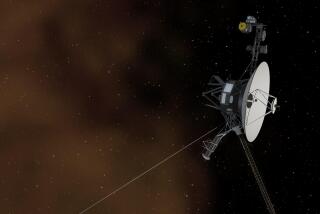Balky Telescopes Prove Handful for Shuttle Crew
HUNTSVILLE, Ala. — After losing nearly a full day of precious viewing time, engineers made substantial progress Monday toward taming four recalcitrant telescopes aboard the space shuttle Columbia.
“It’s coming together,” mission manager Jack Jones said, referring to the $150-million Astro Observatory that was designed to study the universe as it has never been studied before.
Problems with the sensitive, computer-driven system that is supposed to keep the four telescopes aboard Columbia locked on their celestial targets annoyed scientists during the first full day of the mission. Finally, astronomer Samuel T. Durrance, a member of the crew, manually positioned the telescopes by using a “joy stick,” and for the first time three of the units began taking scientific data.
“That’s a milestone,” Durrance beamed to Mission Control, which for the first time is located at the Marshall Space Flight Center here.
“Hot dog, we love it,” came the answer from the ground.
That limited success, however, does not mean the crew’s problems are behind them. It takes far longer to manually manipulate the telescopes, and unless the computer system is brought entirely under control soon the scientists could lose much of the data they hope to collect during the 10-day flight.
The observatory was designed to locate celestial targets automatically and then lock on them precisely for as long as necessary. The key players in that program are the computers, a series of sensors and three small telescopes called “star trackers.” The trackers are programmed to recognize specific patterns of stars so that the telescopes can be oriented and focused on the right targets.
The problem, Jones said, is that the star trackers turned out to be too sensitive, and thus became confused and were unable to recognize the right stars. That necessitated reprogramming the computers aboard Astro so that the trackers would find the right stars.
Considerable progress was made during the day, Jones said, and the trackers were finally able to keep the telescopes on target once the crew manually pointed them at the right part of the sky.
The problem with the star trackers is nearly identical to one that has plagued the Hubble Space Telescope ever since it was launched last April. The Hubble’s star trackers were also too sensitive, and thus easily confused, and engineers have only recently cleared up that problem.
The four telescopes aboard Columbia will study ultraviolet light and X-rays from space, and that can only be done above the Earth’s absorbing atmosphere. Ultraviolet light and X-rays are emitted during some of the hottest, and most violent, events in the universe. That includes such things as exploding stars and material being swallowed by black holes.
Two of the ultraviolet telescopes, as well as an X-ray telescope from the Goddard Space Flight Center, will study how those emissions are absorbed in interstellar gases. That in turn will tell scientists about the chemical composition of the gas, and even about the dynamics of the celestial object that emitted the radiation.
The fourth telescope, also from Goddard, will produce ultraviolet photographs of various targets but those will not be developed until after the shuttle lands.
Officials were optimistic that the problems with the pointing system would be resolved sometime Monday night.
More to Read
Sign up for Essential California
The most important California stories and recommendations in your inbox every morning.
You may occasionally receive promotional content from the Los Angeles Times.










